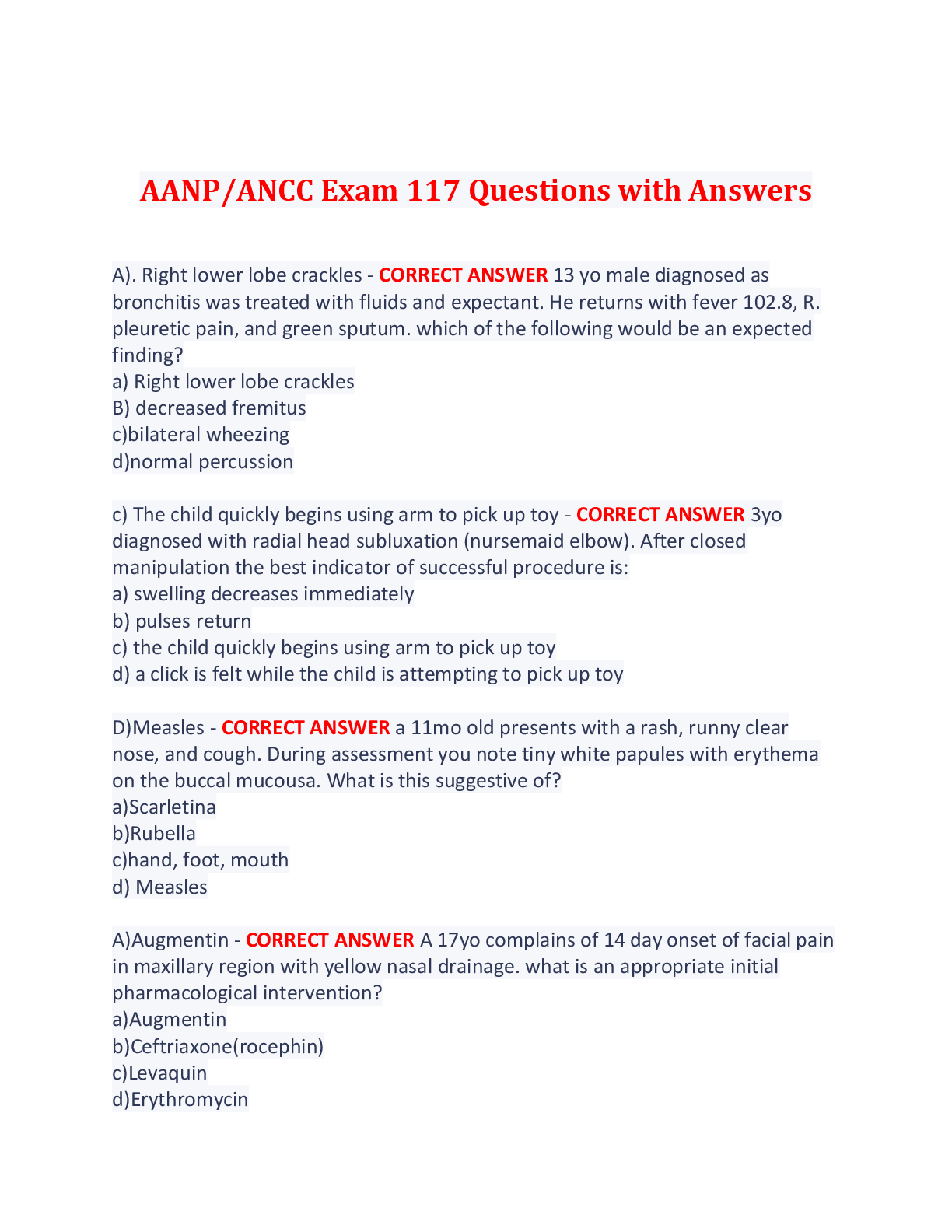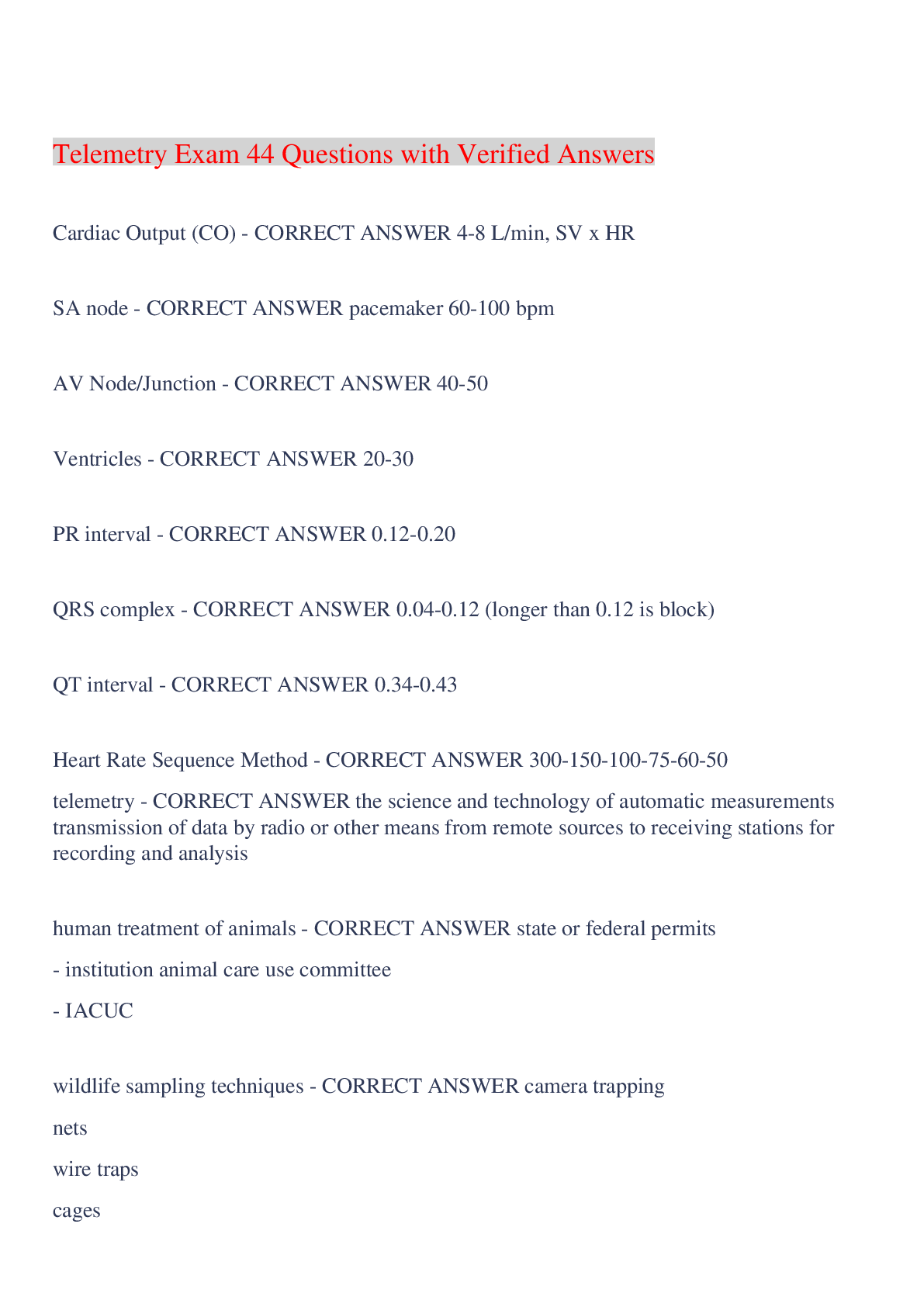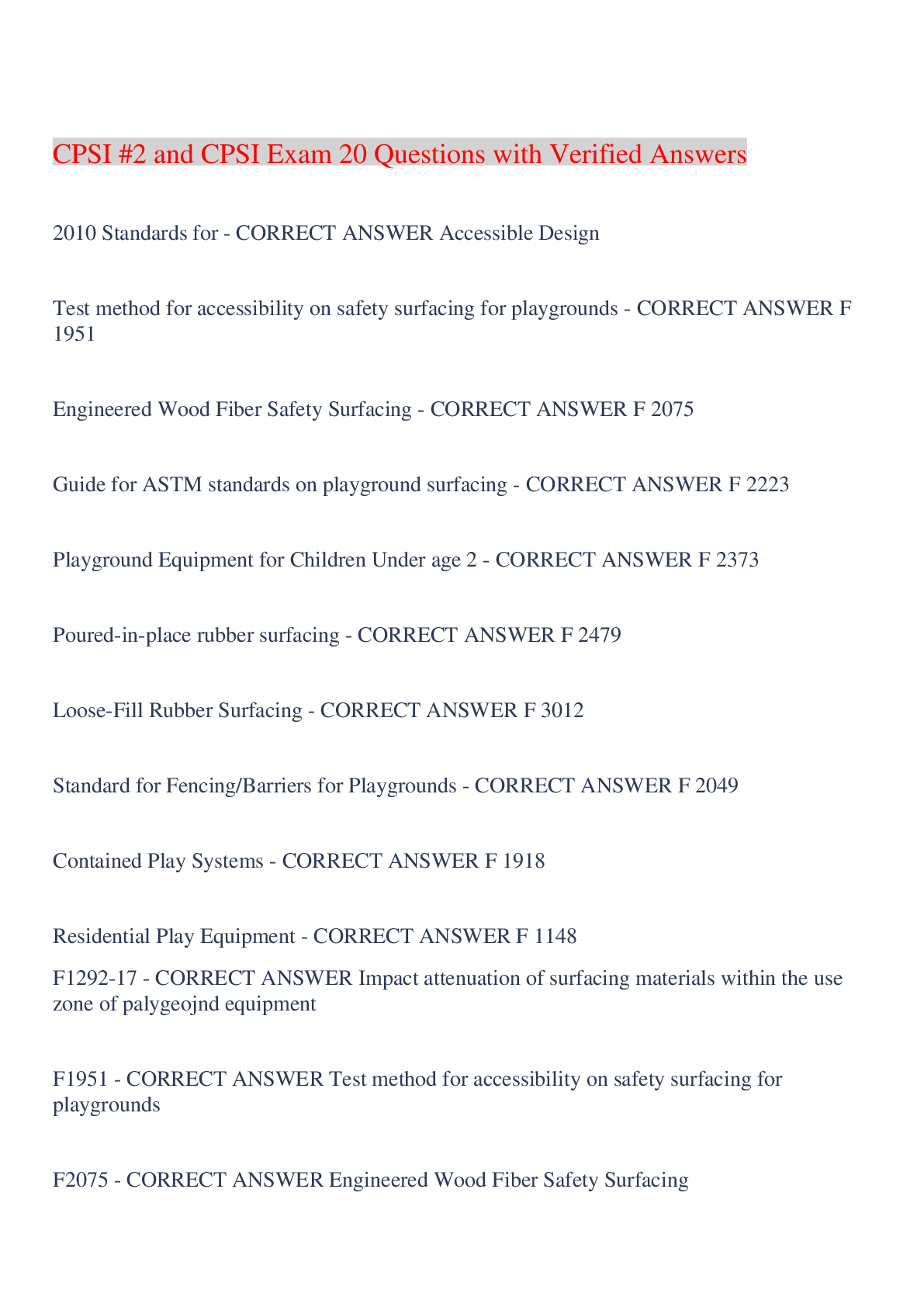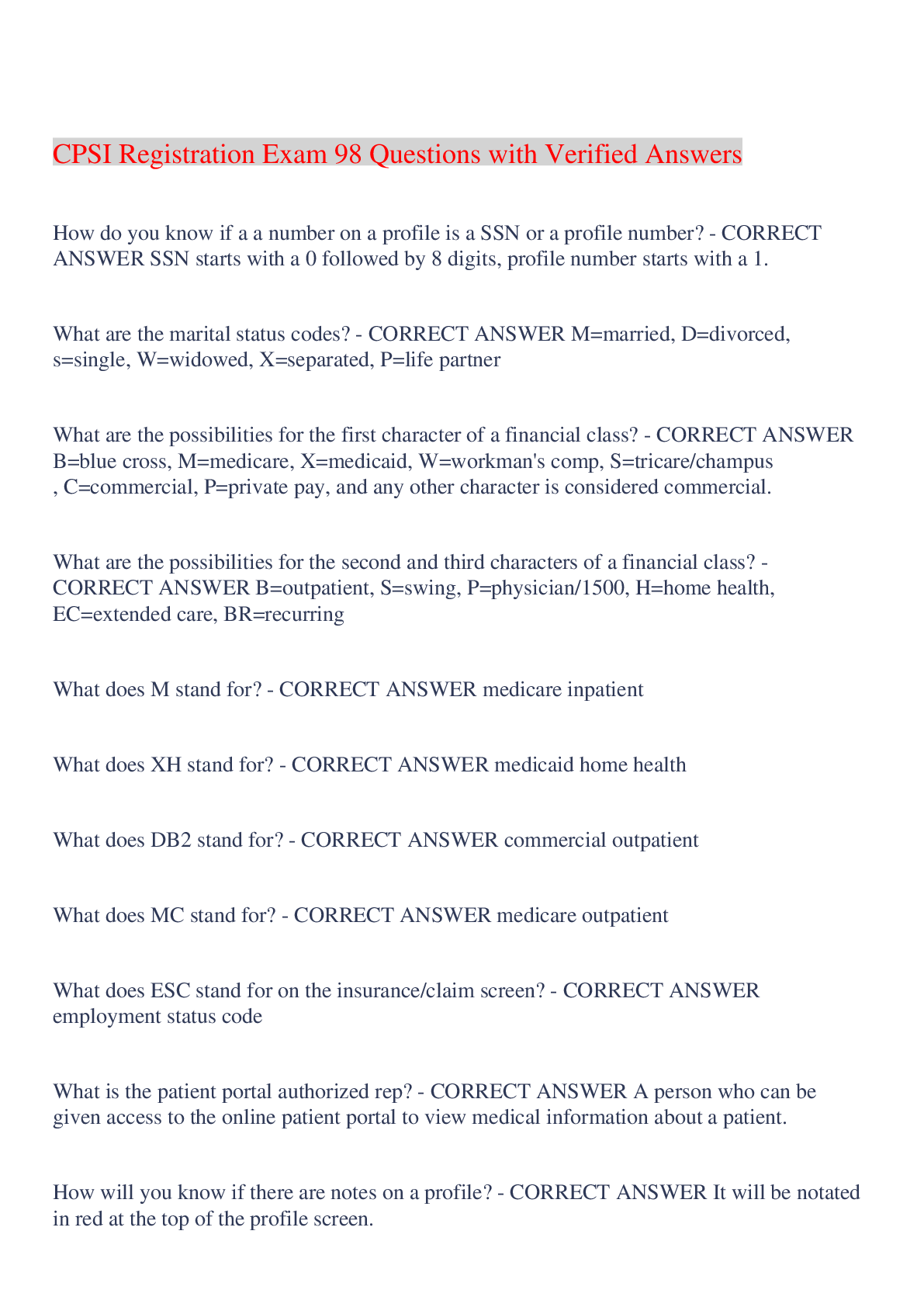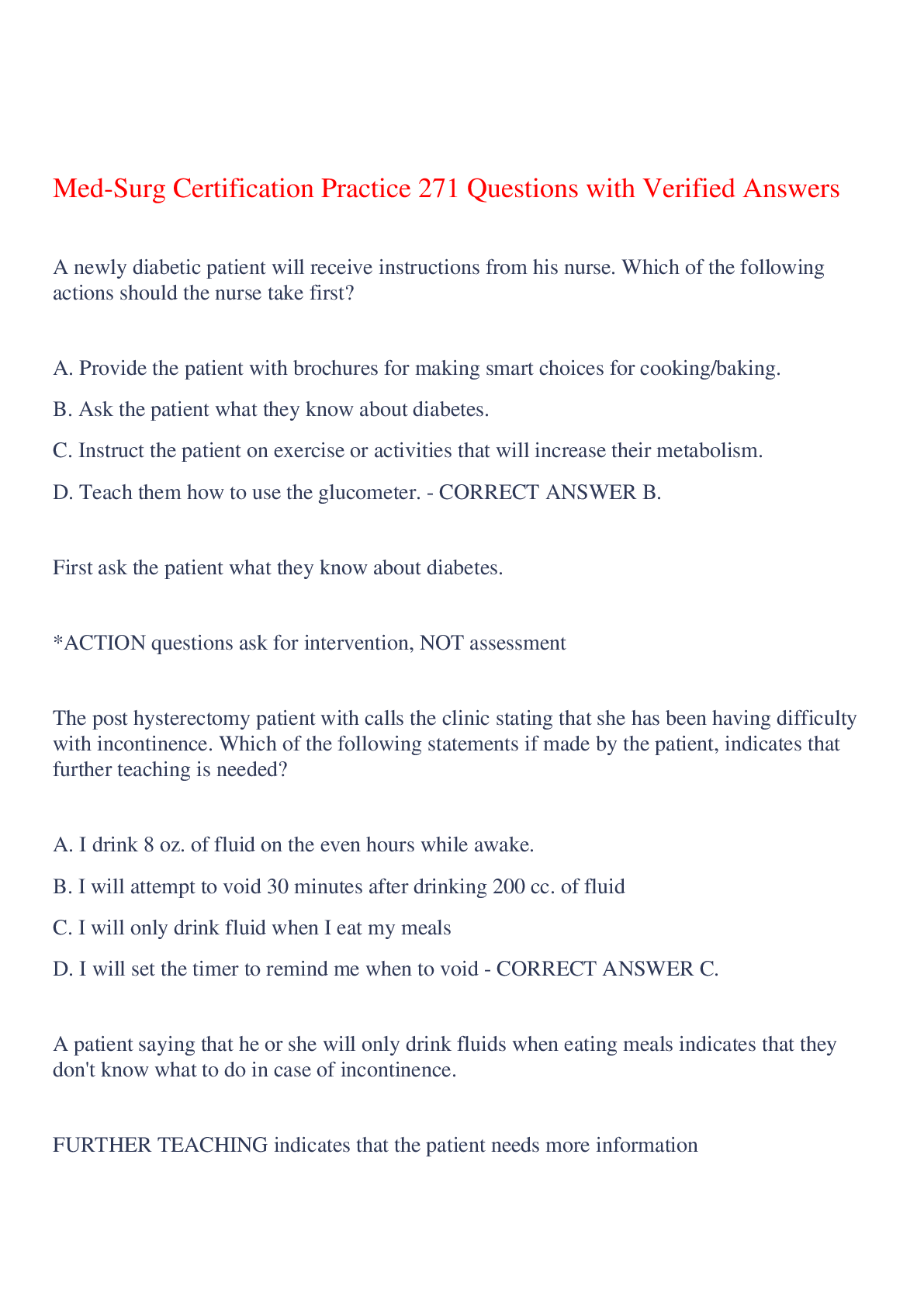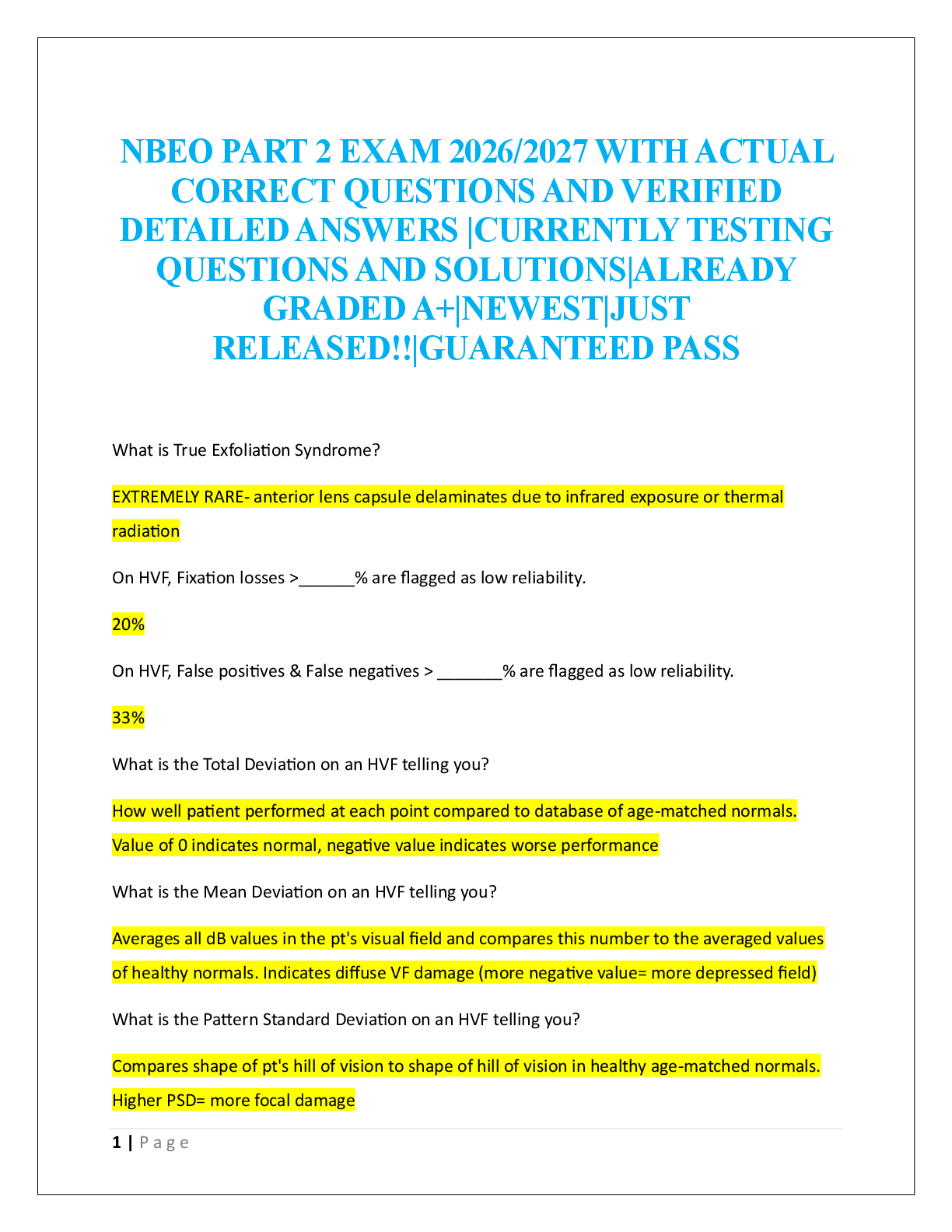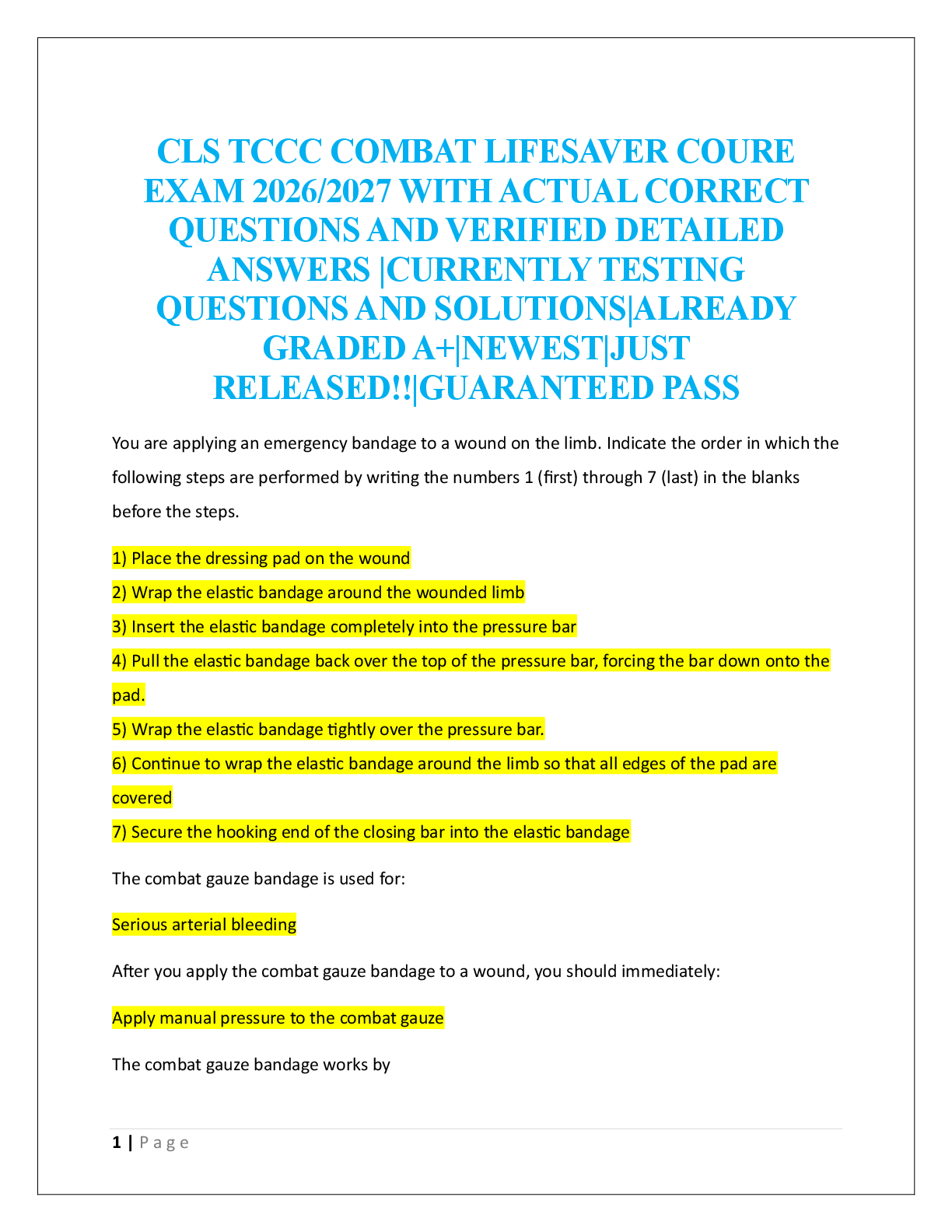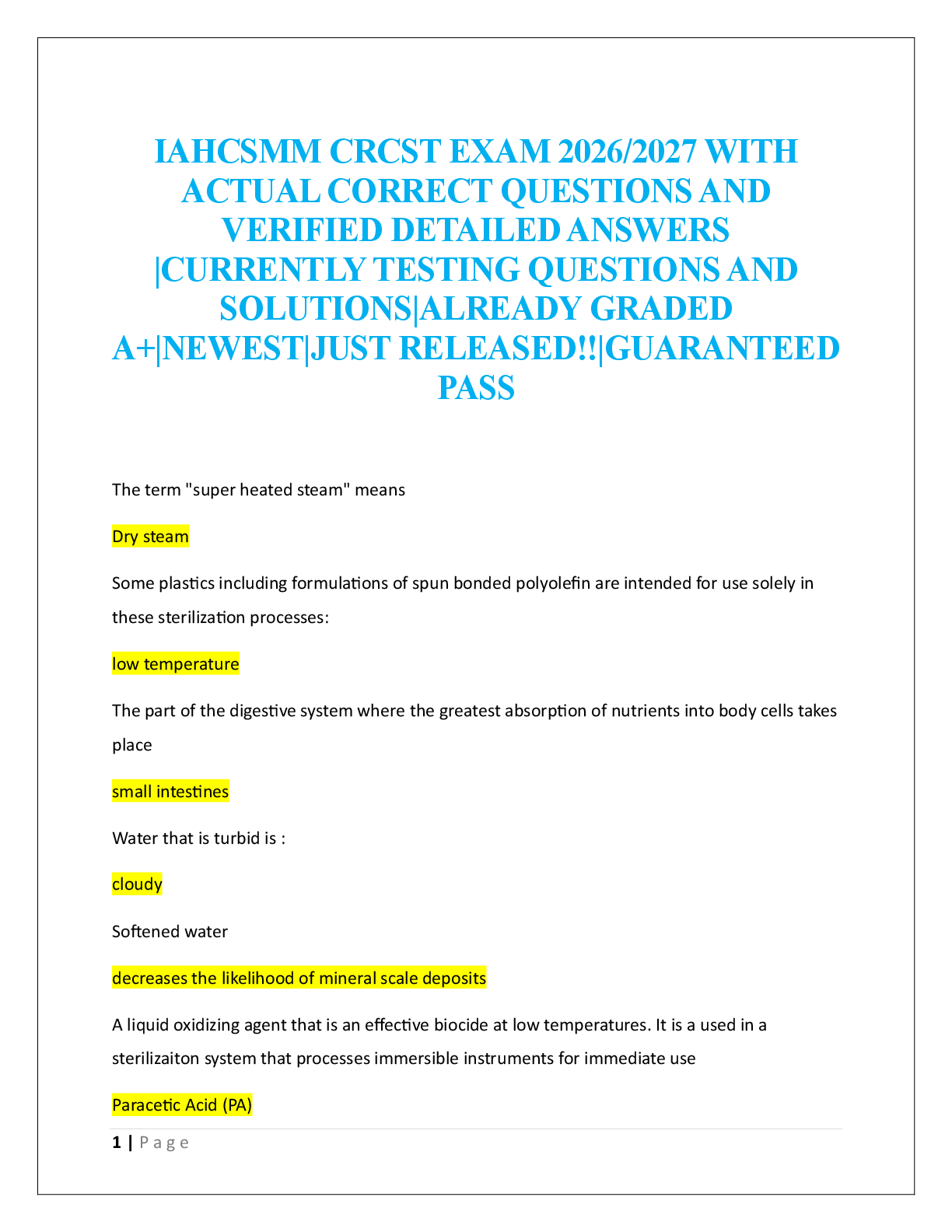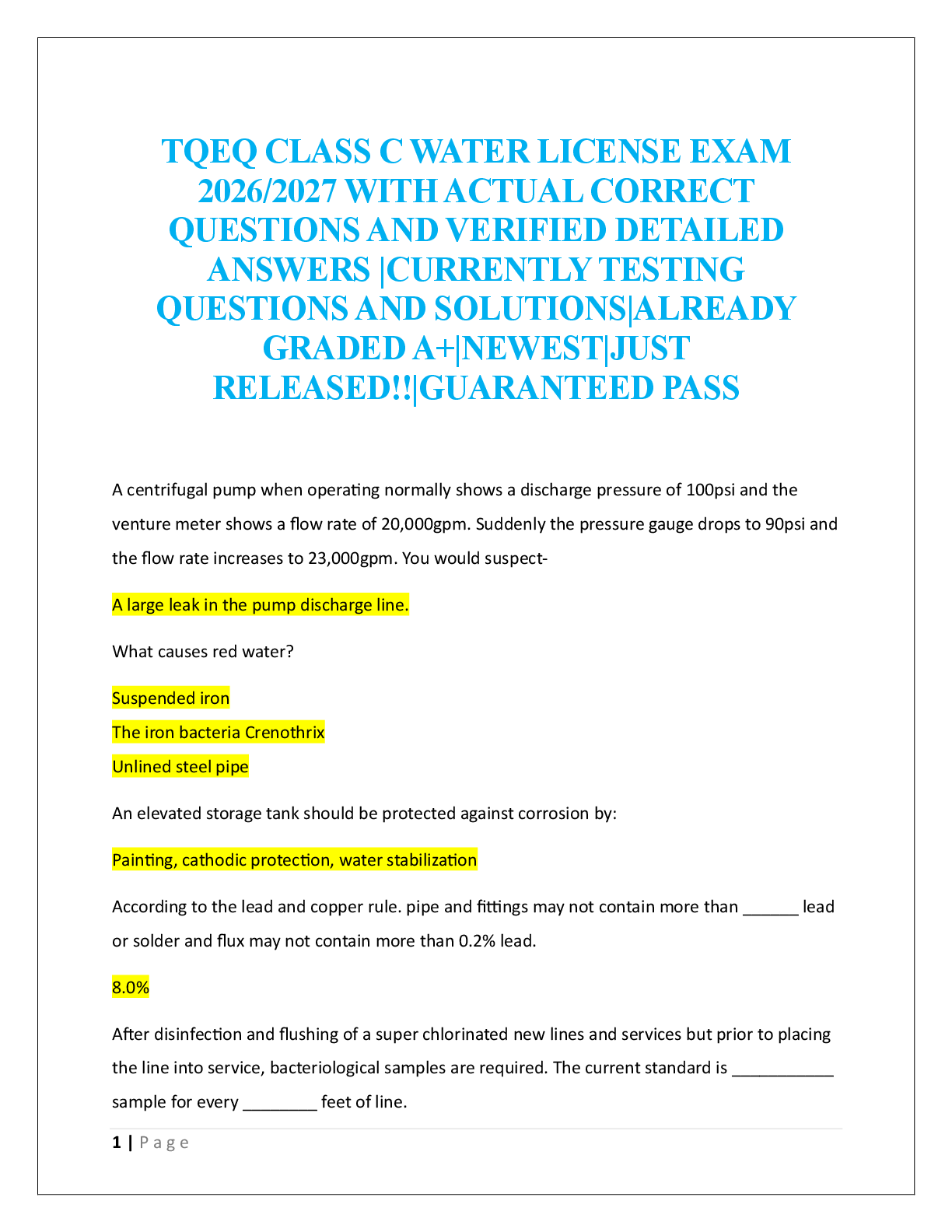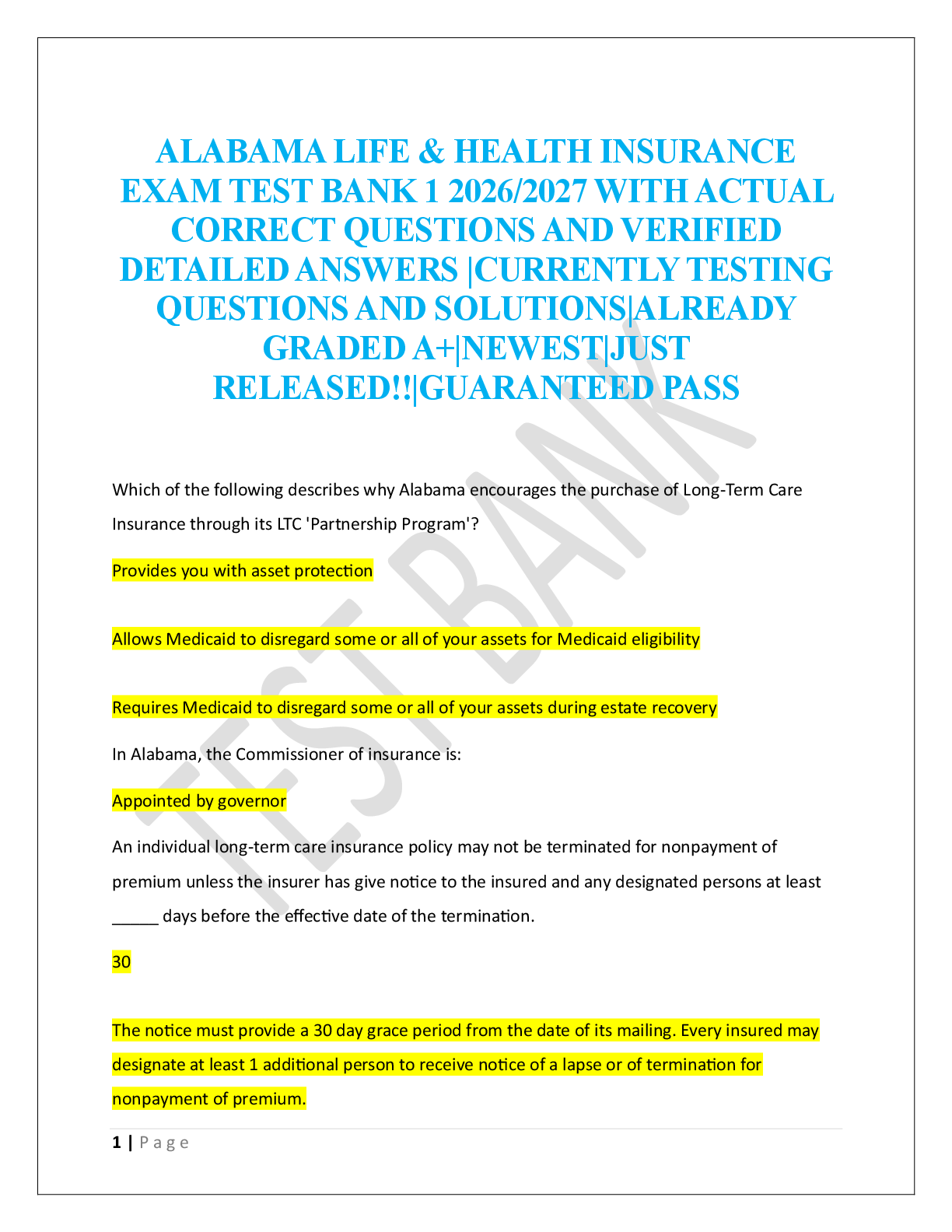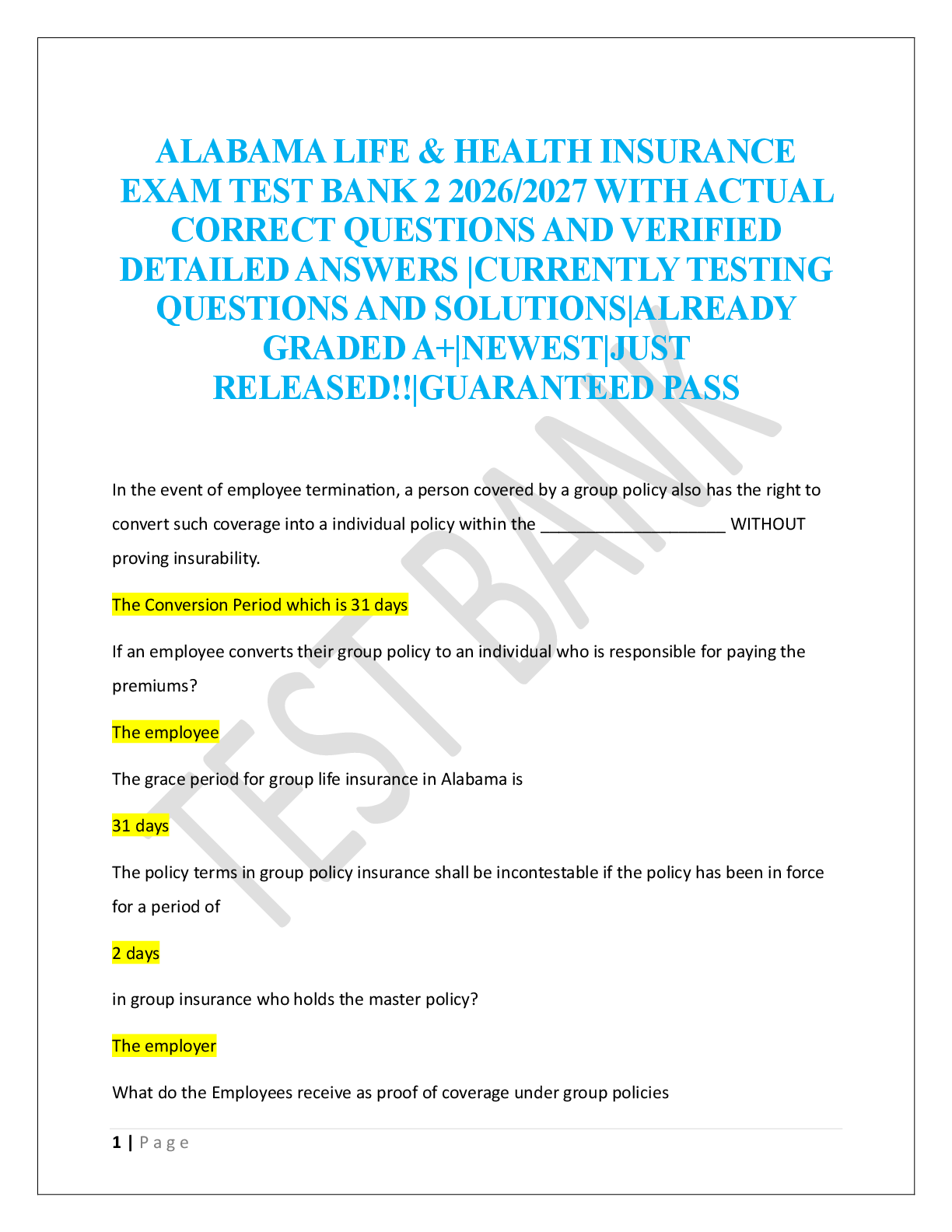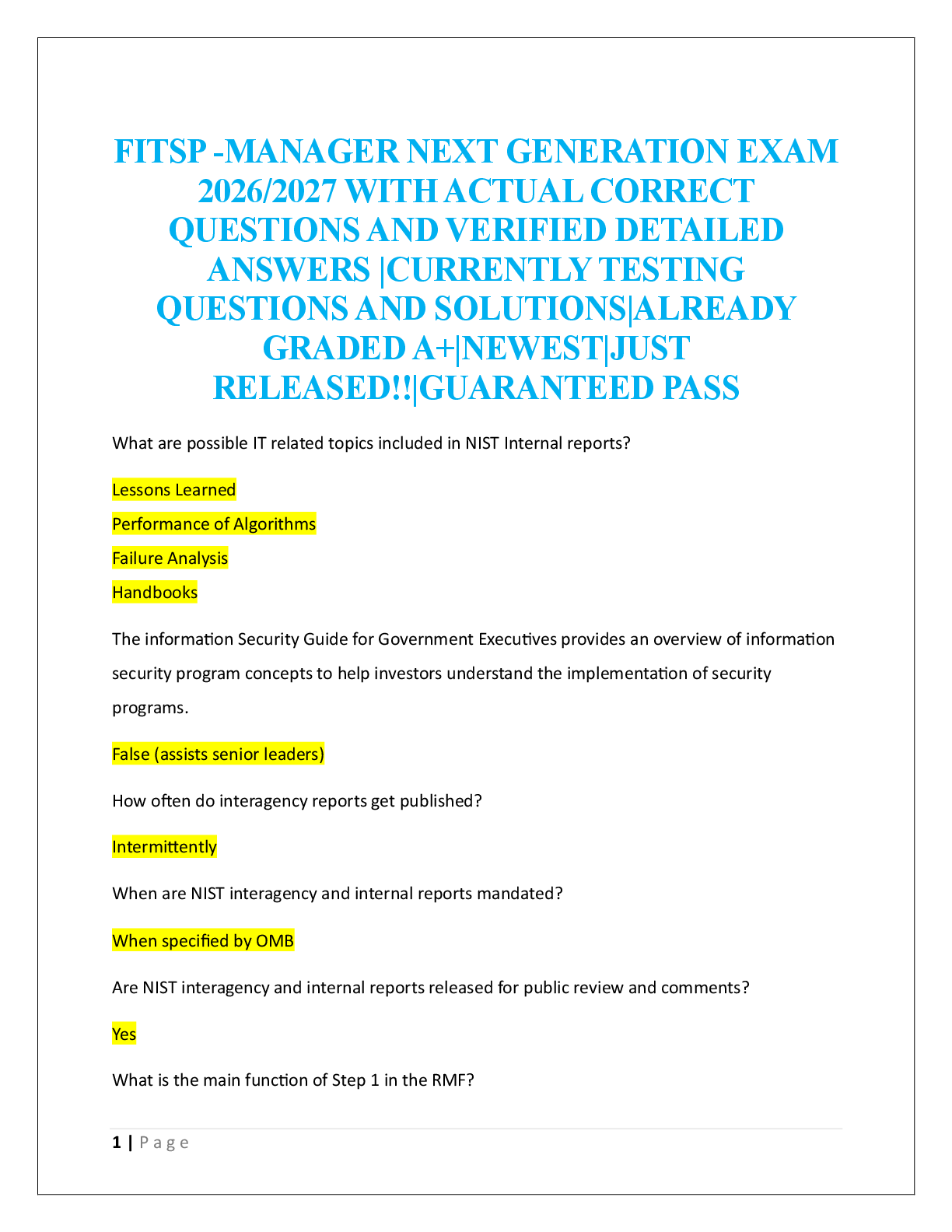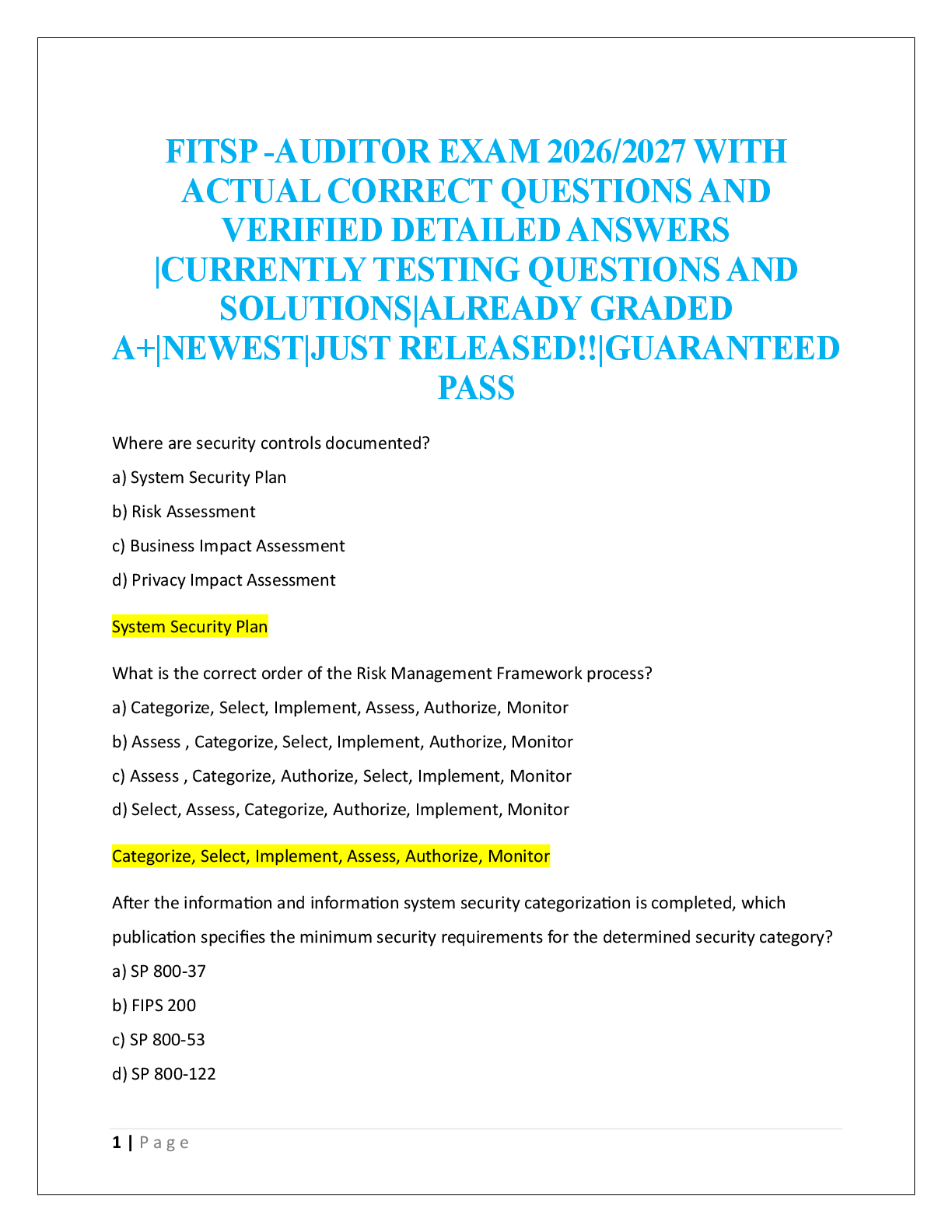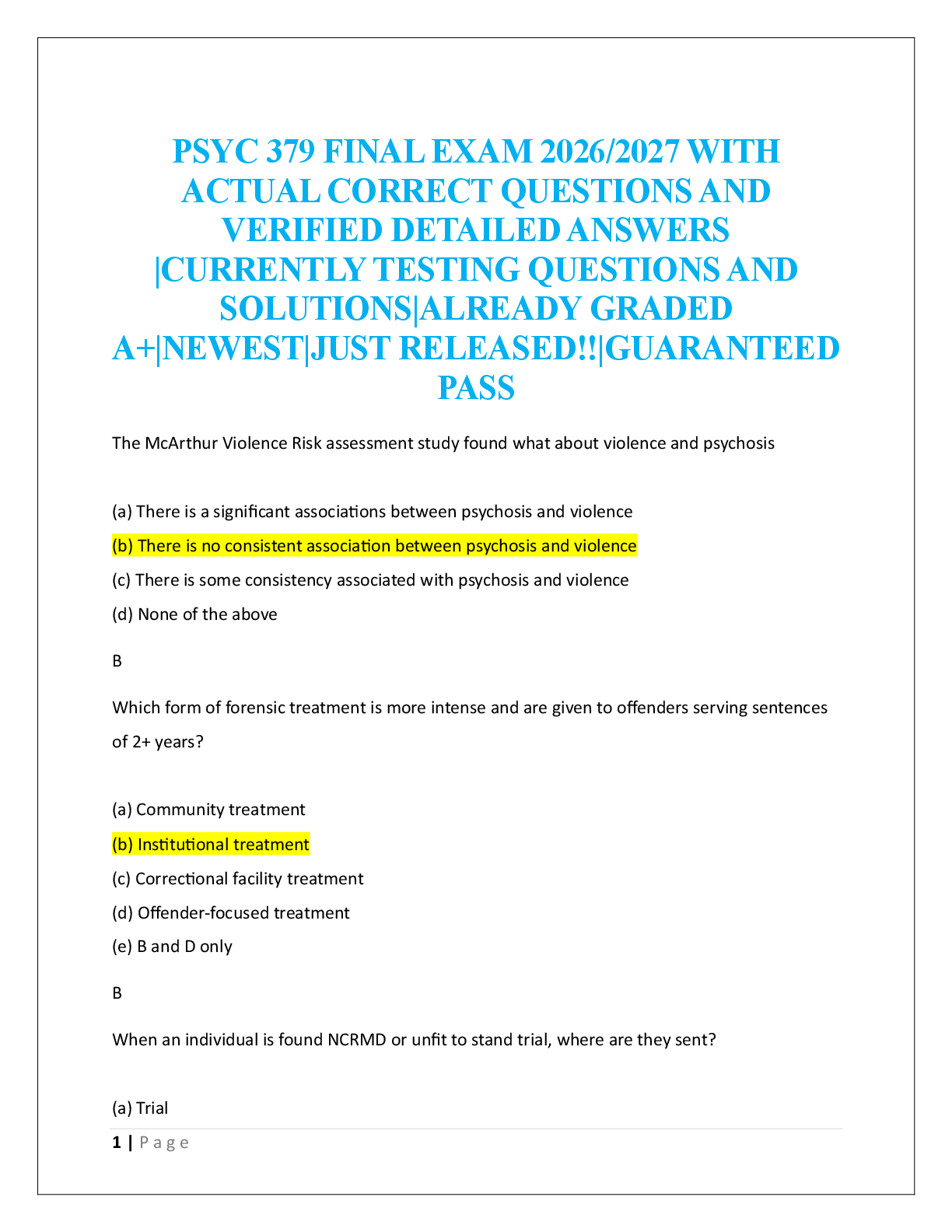KN 200 Exam 2| 49 Questions with Answers 2023,100% CORRECT
Document Content and Description Below
KN 200 Exam 2| 49 Questions with Answers 2023 Disjoint - CORRECT ANSWER Non-disjoint - CORRECT ANSWER Complement of Event A - CORRECT ANSWER • Assumegivenprocedurehas n different si ... mple events and that each simple event has equal chance of occurring • Event(A)canoccurinsof these n ways • Requiresequallylikely outcomes..... - CORRECT ANSWER P(A)=s/n = # of ways (A) can occur/ # of different simple events Conduct/observeaprocedure, and count number of times event (A) actually occurs • Observed results approximate actual - CORRECT ANSWER P(A)=#oftimes(A)occurred/ # of times procedure was repeated Compound event - CORRECT ANSWER -Any event combining ≥ 2 simple events - Union probability (inclusive) P(A U B) - CORRECT ANSWER in a single trial, the probability that either event (A) occurs or event (B) occurs (or they both occur) as the single outcome of the procedure Multiplication rule - CORRECT ANSWER Multiply probability of event (A) and probability of event (B) - P(B) must take into account previous occurrence of event (A) P(A and B) = P(A) * P(B|A) Addition rule - CORRECT ANSWER Find the total number of ways event (A) can occur n and the number of ways event (B) can occur, and find that total in a way that no outcome is counted more than once P(AorB)=P(A)+P(B) -P(AandB)/n P(A ∩ B) - CORRECT ANSWER probability that event (A) occurs in a first trial and event (B) occurs in a second trial Addition Rule VS. Multiplication Rule - CORRECT ANSWER Add P(A) and P(B), being careful to add in such a way that every outcome is counted only once VS. multiply P(A) and P(B), being careful that probability of event (B) takes into account previous occurrence of event (A) At Least one - CORRECT ANSWER Probability among several trials that at least one of some specified event occurs P(at least one) = 1 - P(none) Conditional Probability - CORRECT ANSWER probability of event is probability obtained with additional information that some other event has already occurred • Does not equal probability of event (A), given event (B) has already occurred P(B|A)= P(AandB)/P(A) Permutations Rule - CORRECT ANSWER • Different orderings of same items counted separately - Whole number - No repetition of items Combinations Rule - CORRECT ANSWER • Different orderings of same items not counted separately - No repetition of items nCr =n!/(n-r)!r! Fundamental Counting Rule - CORRECT ANSWER Number of ways two events can occur, given first event can occur m ways and second event can occur n way: sample space= m*n... Factorial Rule - CORRECT ANSWER Number of permutations of n different items can be arranged when all n selected: nPn = n! [n*(n-1)*(n-2)...] Permutations Rule (all items different) - CORRECT ANSWER nPr = N!/(n-r)! [N = total number of items] Permutations Rule (some identical items) - CORRECT ANSWER n!/n1!n2!...nk! A multiple-exam has 10 questions. Each question has 5 answer choices. If 1 of 5 choices is selected for each of 10 questions, in how many ways can exam questions be answered? - CORRECT ANSWER Must occur simultaneously m*n...=9765625 possibilities In how many different ways can 1st, 2nd, and 3rd place be decided among the 12 horses of the Kentucky Derby, disregarding skill, breeding, training, etc.? - CORRECT ANSWER 12 horses and want 3: nPr =1320 How many 5 card poker hands are there with 3 clubs and 2 diamonds? - CORRECT ANSWER 13 clubs and want 3:nCr= 286 ways for 3 clubs 13 diamonds and want 2: nCr=78 ways for 2 diamonds Must occur simultaneously: m*n=22308 possibilities Random variable - CORRECT ANSWER A variable, x, that has a single numerical value, n, determined by chance for each outcome Probability distribution - CORRECT ANSWER A description that gives probability for each value of the random variable Probability Distribution 3 Requirements - CORRECT ANSWER 1.Numerical random variable,x,and its values are associated with corresponding probabilities 2.Sum of all probability equals 1 ∑ P (x) = 1 3.Each probability value is between 0 and 1 0 ≤ P (x) ≤ 1 Discrete random variable - CORRECT ANSWER - A finite or countable number of values • Infinite number of values but result from counting process Continuous - CORRECT ANSWER - Infinite number of values • Values associated with measurements on continuous scale without gaps/interruptions Rare Event Rule - CORRECT ANSWER If, under a given assumption, the probability of a particular event is extremely small, conclude that the assumption is probably not correct. Probability Distribution (Mean, Variance, and Standard Deviation) - CORRECT ANSWER Mean: μ =Σ[x⋅P(x)] Variance: σ2 =Σ[(x−μ)2⋅P(x)] Standard Deviation σ = Square root(Σ[(x2*P(x)]−μ2) Expected Value - CORRECT ANSWER - Mean value of the outcomes E = Σ[x ⋅ P(x)] Range Rule of Thumb - CORRECT ANSWER - Most values are within 2 SDs of the mean -"Unusual" values are outside the limits: max usual value= μ−2σ min usual value = μ + 2σ Probability to Determine Unusually low results - CORRECT ANSWER x successes among n trials is an unusually low number of successes if P (≤ x) ≤ 0.05 Probabilities to Determine Unusual Unusually high Results - CORRECT ANSWER x successes among n trials is unusually high number of successes if P (≥ x) ≤ 0.05 Binomial Probability Distribution Definition - CORRECT ANSWER For circumstances in which outcomes belong to two relevant categories(success / failure) Binomial Probability Distribution Requirements - CORRECT ANSWER 1. Procedure has fixed number of trials 2. Trials must be independent 3. Each trial must have all outcomes classified into two categories (e.g., success/failure) 4. Probability of success remains same in all trials Probability of success - CORRECT ANSWER P (S) = p Binomial Probability Formula - CORRECT ANSWER For x= 0,1,2,....,n Probability of failure - CORRECT ANSWER P (F) = 1 - p = q Define: • n = • x = • p = • q = P(X) - CORRECT ANSWER • = fixed number of trials • = specific number of successes in n trials - Any whole number between 0 and n(inclusive) • = probability of success in one of n trials • = probability of failure in one of the n trials = probability of getting exactly x successes among n trials Binomial Probability (Mean, Variance, and Standard Deviation) - CORRECT ANSWER Mean: μ=n*p Variance: σ2= n*p*q Standard Deviation: σ= Square root(n*p*q) Poisson Distribution Requirements - CORRECT ANSWER 1. Random variable x is number of occurrences of an event over some interval 2. Occurrences must be random 3. Occurrences must be independent of each other 4. Occurrences must be uniformly distributed over interval being used Poisson Distribution - CORRECT ANSWER Discrete probability distribution • Describes behavior of rare events (with small probabilities) • occurrences of specific event over specified interval - Random variable x is the number of occurrences of the event in an interval • Time, distance, area, volume, etc. Poisson Distribution Formula - CORRECT ANSWER Poisson Distribution (Mean and Standard Deviation) - CORRECT ANSWER Mean: μ Standard deviation: σ= Square root(μ) Binomial vs. Poisson Distribution - CORRECT ANSWER • Affected by sample size, n, and probability, p • Possible values of random variable x are 0, 1, ..., n VS. • Affected by mean, μ • Possible values of 0, 1, 2, ..., ∞ Your UIN consists of 9 numbers in a particular order and repetition of numbers is allowed. lf randomly selecting digits for a UlN, what is the probability you guess your own UIN? - CORRECT ANSWER (10) to the 9th power= 1000000000 P= 1/1000000000 Let's say 2.8 goals is the average number of goals scored per game this year by NHL teams. How likely are the Blackhawks to score exactly 3 goals in one 60 minute game? Given that there are an average of x (2.8) occurrences of an event (goal) over a time period (60 min), the probability there will be exactly k (3) occurrences is: - CORRECT ANSWER p = (x^k * e^-x) / k! or p = (2.8^3 * 2.71828^-2.8) / 3! = 0.22. The probability of a shutout (0 goals) is 0.06. Identify if following scenarios are (binomial or Poisson's) probability distribution: 1. Probability that all 5 of your randomly-chosen group members will have passed the midterm 2. Probability that number of lions seen on a 7-day safari is exactly 2 3. Probability that exactly 3 treadmills are sold in one day from one store - CORRECT ANSWER (1,2) binomial 3. Poisson Mars, lnc. claims that 16% of its M&M plain candies are green. A sample of 100 M&Ms is randomly selected. a. Find the mean and SD for the numbers of green M&Ms in such groups of 100. - CORRECT ANSWER μ=np= 100(.16)=16 σ= Square root(npq)= Squareroot(100(.16)*.84)= 3.7 [Show More]
Last updated: 2 years ago
Preview 1 out of 8 pages

Buy this document to get the full access instantly
Instant Download Access after purchase
Buy NowInstant download
We Accept:

Reviews( 0 )
$9.00
Can't find what you want? Try our AI powered Search
Document information
Connected school, study & course
About the document
Uploaded On
Jul 09, 2023
Number of pages
8
Written in
All
Additional information
This document has been written for:
Uploaded
Jul 09, 2023
Downloads
0
Views
97






